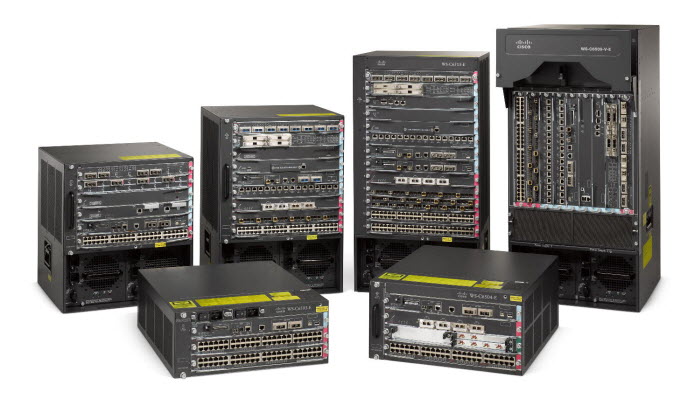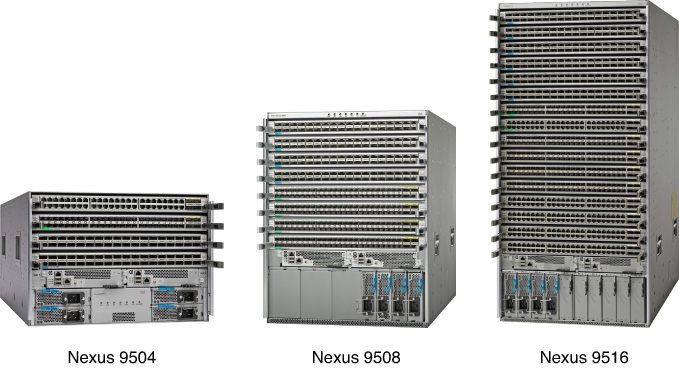
Why choose Cisco Nexus 9000 switches? You may list at least 10 reasons, such as fast, scalable, secure. What are the bright features of Nexus 9000 series comparing to the popular Catalyst 6500 core switches?
The Nexus 9500 and Catalyst 6500 are both highly reliable core switches but serve a different purpose.
Catalyst 6500 Switching platform is a perfect fit for the campus core/backbone, where the Nexus 9500 Switching Series is aimed for the Data Center core/ aggregation.
Catalyst 6500 Series Switches

The Nexus 9500 can run in both classic NX-OS or ACI mode; Cisco‘s next generation Application Centric Infrastructure.
Nexus 9500 Cloud Scale Switches

ARCHITECTURE
- The Catalyst 6500 supports both centralized forwarding, where the supervisor makes the forwarding decision, or distributed forwarding, where the line card makes the forwarding decision.
- Cisco Nexus 9500 Series performs all data plane processing on the I/O modules and fabric modules. This frees up the supervisor to focus exclusively on scaling the control plane, which is important in large scale Data Centers.
SWITCH FABRIC
- The Nexus 9500 has the switch fabric or fabric modules located in a separate part of the chassis, independent of other cards. Due to this architecture, the Nexus 9500 supervisors are only managing the control plane.
- The linecards on the Catalyst 6500 are integrated in the switch fabric onto the supervisor itself.
INTERFACES
100GbE
The Nexus 9500 platform has a 8-port 100 Gigabit Ethernet CFP2 line card, designed for use in an aggregation switch role.
40GbE
The modern Data Centers are going from a 10GbE to a 40GbE transition and the Nexus 9500 support different 40GbE QSFP+ line cards. The Catalyst 6500 now also has the possibility to add a 40GbE line card.
1/10GbE
As the Nexus 9500 is a pure Data Center switch, there are 1/10Gbase-T and 1/10GbE SFP+ linecards available. The Catalyst 6500 platform, which is aimed for the campus, still focusses on pure gigabit interfaces but also has 10GbE linecards for connecting the aggregation/access switches.
But for 10GbE, the Nexus 9500 has a number of high-density 10GbE options available that the Catalyst 6500 does not, such as a 48-port SFP+ as well as a 48 port 10GBase-T line cards. The Catalyst 6500 only has 4-, 8-, or 16-port 10GbE line cards available.
FEATURES
Both the Nexus 9500 and Catalyst 6500 share a common set of high-end L3 switching features, such as full routing protocol support and QoS capabilities. However, each platform has unique capabilities that often influence which platform to use. Below are some platform-specific features:
VSS (Virtual Switching System)
Virtual Switching System (VSS) mode is a Cisco clustering technology that join two Catalyst 6500 Series Switches into a single virtual switch with a unified control plane. The advantage of this design is a multi-chassis link aggregation and high availability without Spanning Tree concerns. VSS members are connected by virtual switch links (VSLs) using standard Gigabit or 10 Gigabit Ethernet connections between the VSS members.
VSS simplifies network configuration and operation by providing a loop-free Layer 2 topology using two Catalyst 6500 switches acting as one big Virtual switch.
vPC (Virtual Port-Channel)
A virtual PortChannel (vPC) allows links that are physically connected to two different Cisco Nexus devices to appear as a single PortChannel to a third device. The third device can be a switch, server, or any other networking device that supports EtherChannel. A vPC provides Layer 2 multipathing, eliminates Spanning Tree Protocol blocked ports, allows you to create redundancy by increasing bandwidth, enabling multiple parallel paths between nodes and traffic load balancing in cases in which alternative paths exist. vPC, compared to VSS, doens’t rely on a unified control plane so they operate independently.
Service Modules
The Catalyst 6500 platform has the capability to add a number of service module line cards that can extend the capabilities of the system. Some examples of service modules are the ASA-SM card, which provides high throughput firewall capabilities, ACE cards that provide load-balancing or Wireless Service Controllers, that are able to manage up to 1000 Access Points.
WAN and Services Interfaces
Through the use of the Shared Port Adapter Interface Processor (SIP) Modules, the Catalyst 6500 can support a wide range of WAN interfaces, allowing great flexibility in how the switch can be used. For applications that demand fine-grained QoS or additional Ethernet services, some of the 7600 Ethernet Services cards are also supported.
Fabric Extenders
The Nexus 9500 supports the use of the Nexus 2200/2300 Series Fabric Extenders to expand the system ports and provide a large-scale virtual chassis in the data center. Fabric Extenders can be seen as a remote linecard and are managed by the Nexus 9500, which simplifies administration/management.
VXLAN and ACI
The Nexus 9500 has support for Virtual Extensible LAN (VXLAN; an overlay network protocol) bridging and routing, supporting and accelerating communication between virtual and physical servers across multiple data centers.
The Nexus 9000 series support both the classic NX-OS mode and the ACI (Application Centric Infrastrucure) mode. Cisco Application Centric Infrastructure (ACI) is an innovative architecture that radically simplifies, optimizes, and accelerates the entire application deployment lifecycle.
Cisco ACI uses a holistic systems-based approach, with tight integration between physical and virtual elements, an open ecosystem model, and innovation-spanning application-specific integrated circuits (ASICs), hardware, and software. This unique approach uses a common policy-based operating model across ACI-ready network, and security elements (computing, storage in future), overcoming IT silos and drastically reducing costs and complexity.
Cisco ACI redefines the power of IT, enabling IT to be more responsive to changing business and application needs, enhancing agility, and adding business value.
SOFTWARE AND LICENSING
IOS is running on the Catalyst 6500 plaform, providing the same CLI command set as any other Catalyst Switch. The licensing is based on the software version you buy (Advanced Enterprise vs Advanced IP services, …).
The Nexus 9500 runs NX-OS, a full-featured, modular, and scalable network operating system has a easy licensing scheme. The 9500 platform has only two licenses available in NX-OS mode: L3 enterprise license (OSFP, BGP, L3 IS-IS, PIM, GRE, VXLAN, EIGRP, BGP eVPN,…) and the Network Services license which enables Intelligent Traffic Director (ITD), a layer 4 load balancing mechanism.
Reference from https://thelibrary.solutions/library/N9K_vs_Cat6500.pdf
Get the Best Prices on Cisco Nexus 9500 and Catalyst 6500
More Related
Why Choose Cisco Nexus 9000 Series Switches? Top Five Reasons…
Cisco Nexus 9500 Comparison-Chassis, Supervisors and Modules…
Cisco 9500 Nexus Switch Overview-Model Comparison


